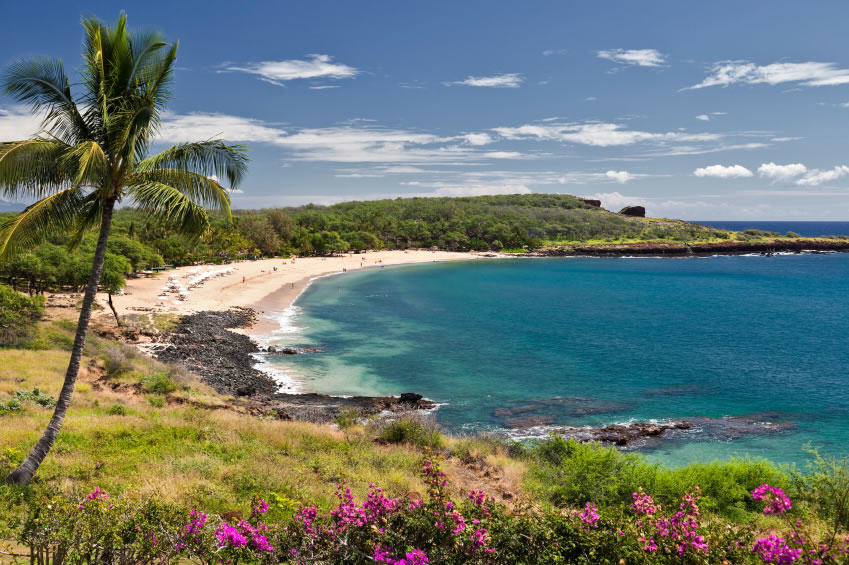Today I am staying in a Lanai Vacation Rental and enjoying the beautiful island of Lanai, an island with a history as rich as its natural environment.
Beginning in the 1920s, Lanai was dominated by a vast pineapple plantation that eventually became the largest pineapple plantation in the world. The island’s central population lived in Lanai City, a company town situated at an elevation of about 1,700 feet above sea level, and set beneath the hills of Lanaihale.
Today Lanai City remains the town’s central population area, and early 1900s era homes (many brightly painted) still line the streets. At the center of Lanai is the grassy lawn of six-block-long Dole Park. Hawaiian Church is at the corner of Gay and 5th Streets. Very few of Lanai’s residents live outside of Lanai City.
Lanai City was originally built by James Drummond Dole (1877-1958), a pioneer in the pineapple industry. Dole purchased Lanai in 1922 for $1,100,000 and soon had more than 19,000 acres planted, producing almost one-third of the world’s pineapple crop.
Dole formed the Hawaiian Pineapple Company on December 4, 1901 and the first harvest took place in 1903. In 1906, Dole constructed a cannery in the Iwilei district on Oahu. At the time, Dole’s enterprise was the largest fruit factory in the world.
After Dole planted the first pineapples on Lanai in 1922, the pineapple industry dominated Lanai for the next 65 years, producing as many as 250 million of the tasty fruits per year.
Today pineapple is no longer king on Lanai. The last major commercial pineapple harvest on Lanai took place in 1992, though some pineapple “show fields” still adorn the landscape. A tourist oriented economy has now replaced the industrious company town that was once awakened each morning by the plantation whistle.
In 1985, 98% of Lanai was purchased by businessman David H. Murdock, who closed the pineapple plantation. The 1990s saw a marked rise in tourism related activities, and Lanai now has two luxury resorts, including the Manele Bay Hotel on the beach, and the Lodge at Koele in the mountains.
Northwest of Lanai City is Kanepuu Forest Reserve, which offers a self-guided nature trail through a rare Hawaiian lowland forest (the largest preserved native dryland forest in the Hawaiian Islands).
The 590-acre Reserve is owned and managed by the Nature Conservancy, and provides habitat for many native plants and trees. A fifteen-minute loop trail includes informative signs.
Also northwest of Lanai City is a volcanic and eroded landscape known (in recent times) as Garden of the Gods. The area’s erosion is due largely to the overgrazing of the land by non-native animals, including deer, goats and cattle.
In recent times, this barren landscape was given the name, Garden of the Gods. The wind eroded boulders show changing reddish hues as the sun sets, and there are spectacular views of the ocean and Molokai, and sometimes Oahu.
Kaumalapau Harbor, Lanai’s main seaport, is reached by following Kaumalapau Highway (Hwy. 440) west to the end and then turning left and driving about 7 miles.
Kaumalapau Harbor was developed in 1926 by James Drummond Dole and his Hawaiian Pineapple Company (later called Dole Company). Seacliffs along the western side of the harbor reach to 1,000 feet high.
Nanahoa Islet, north of Kaumalapau Harbor on Lanai’s west side, consists of two large pillar stones. According to legend a man named Nanahoa and his wife were turned into these stones.
Near Kaumalapau Harbor is Kahekili’s Leap (or Jump), a cliff that rises about 62 feet above the ocean, and is said to have been a test for ancient warriors who would meet their death if they could not clear the ledge below.
The site’s name also originated from the fact that it was the spot from which torch signals were sent to Maui’s chief, Kahekilinuiahumanu [Kahekili].
In 1778, the young chief, Kamehameha (who would later become King Kamehameha I), went aboard Captain Cook’s ship anchored off Maui. Kamehameha was accompanying Kalaniopuu, the ruler of Hawaii Island.
Hulopoe Beach, southeast of Lanai City, is a great place to swim and snorkel. Spinner dolphins (Hawaiian name: naia) are frequently seen. Tidepools are located one side of the white, sandy beach, which is known for its clear blue waters.
Hulopoe Beach provides a nice place for children to swim, and is fronted by grassy areas nice for picnics. There are also camping facilities. Hulopoe is designated a Marine Life Conservation District.
Lanai’s only public boat harbor, Manele Bay was the main harbor before Kaumalapau Harbor was constructed by Dole and his pineapple operation.
The harbor is now used by fishing boats as well as yachts and other pleasure craft. This is also where the ferry to Maui arrives and departs. Now designated as a Marine Life Conservation District, Manele Bay is also the site of an ancient fishing village.
Hulopoe Beach and Manele Bay are part of a State of Hawaii Marine Life Conservation District. A trail to the top of the ancient spatter cone that separates Hulopoe from Manele Bay provides a great view of the 80-foot high offshore sea stack called Puu Pehe, or Sweetheart Rock.
According to legend a young warrior of Lanai, Makakehau, brought a girl, Pehe, from Maui to the rock and hid her there because she was so beautiful. When she was killed in a storm the distraught warrior retrieved her body from the cave at the base of the rock.
Makakehau then buried Pehe at the rock’s summit and leaped from the cliffs to his death. Puu Pehe means “Pehe’s hill.”
I am enjoying my time on Lanai, and tonight I am going to stay in aLanai Hotel. I really recommend this island to anyone who wants a very relaxing and enjoyable visit on a very beautiful island.

